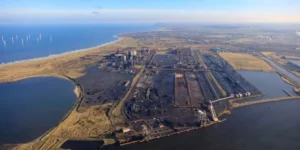ANALYSIS | What does EU’s new 90% emissions reduction target for 2040 mean for green hydrogen?

The European Commission (EC) yesterday presented a recommendation for a 90% net greenhouse gas emissions reduction within the EU by 2040 compared to 1990 levels (building on the planned 55% emissions reduction by 2030) (see panel below).
Before setting this goal, the EC conducted a thorough impact assessment — which was published yesterday in a 605-page report — which determined what the energy system might look like in 2040.
“Renewable hydrogen as [an] energy vector appears as a key technology of the future EU energy system, including to produce e-fuels (both gaseous and liquid) and to contribute to decarbonise the hard-to-abate sectors (such as aviation and maritime transport, among others),” the impact assessment says.
The 90% emissions reduction target — represented by the “S3” scenario in the study — would require 100 million tonnes of oil equivalent (Mtoe) of green hydrogen in 2040 (about 35 million tonnes of H2 per annum [Mtpa]), as well as a further 37Mtoe of e-fuels (made from renewable H2 and captured carbon dioxide or carbon monoxide).
Only 95Mtoe of hydrogen would be consumed in this 2040 scenario, suggesting that 5Mtoe would be exported to non-EU countries, and about 50Mtoe (17.5Mtpa) of this green H2 would be used for the production of e-fuels.
Roughly 17Mtoe (6Mtpa) would be used in industry, with a further 16MToe (5.6Mtpa) in domestic transport, another 1TWh for international shipping (0.3Mtpa), a neglible amount for international aviation, about 6Mtoe (2Mtpa) for non-energy, such as chemicals, and another 6Mtoe listed as “other”, presumably including power (energy storage) and heating.
Article continues below the advert
The assessment explains that hydrogen would be needed for energy storage “to support the operation of the power sector with high shares of variable renewable energies providing seasonal storage”.
Hydrogen would only account for 3% of the energy used in the residential sector in 2040 (about 4Mtoe), with most of residential heating coming from electric heat pumps, biomass and waste, and district heating (and a small amount of natural gas).
However, the impact assessment adds a caveat that “the role of RFNBOs in the decarbonization of the building sector is highly uncertain”.
The EU currently wants to produce 10 million tonnes (around 28.4Mtoe) of green hydrogen by 2030, while importing a further 10 million tonnes from outside the bloc — but it is on track to miss both of these targets.
Transport breakdown
Of the 16Mtoe of green hydrogen used in the transport sector, 90% of this would be consumed by road transport alone.
It adds that 40Mtoe of e-fuels would also be needed in the transport sector, despite saying earlier in the document that only 37Mtoe would be required in total under the S3 scenario. The discrepancy may be due to the fact that it defines e-fuels differently in different parts of the study — the definition includes green ammonia in the transport section of the report, but earlier on, it defines e-fuels as being made from electricity (ie, green hydrogen) and carbon (which does not include ammonia).
In 2040, 5% of the EU’s passenger car fleet would have a fuel-cell drivetrain, the assessment states, requiring about 5Mtoe of H2.
But the demand for hydrogen from heavy goods vehicles (ie, trucks) would be far higher, at about 13% of the EU fleet (including both fuel cells and H2 internal combustion engines), with battery trucks making up around 24% of the truck fleet. More than 50% of these vehicles would still be running on conventional diesel in 2040.
Due to the higher efficiency of batteries compared to hydrogen, electric trucks would only require about 6Mtoe, compared to about 9Mtoe (3.2Mtpa) for H2 trucks.
About 16% of the bus and coach fleet would be powered by hydrogen in 2040, with 37% powered by batteries, and the remaining 47% still running on conventional fossil fuels (including diesel hybrids).
Trains will go almost entirely electric, with less than 1% running on hydrogen — on routes where electrification (overhead cables or batteries) is not possible.
International shipping will be dominated by biofuels and e-fuels in 2040 (each requiring about 15Mtoe), with less than 1Mtoe of hydrogen being used directly.
In aviation, about two-thirds of the energy required by planes within the EU and leaving the EU will still come from fossil fuels in the 2040 S3 scenario, with a further 24% coming from biofuels, 13% from e-fuels (about 5Mtoe) and 1.1% from the direct use of hydrogen (about 0.4Mtpa).
Announcing the new EU target, European Commission executive vice-president Maroš Šefčovič stated:
“After careful thought and consideration, we are recommending that by 2040, the European Union reduces its emissions by 90 percent, compared to 1990 levels.
“With our recommendation, we are staying the course of the climate transition as agreed by EU leaders, as it will be increasingly important for our global competitiveness.
“And it comes at a crucial moment in the debate around the future path of Europe’s green transition.
“The essence of the debate across many countries is how to decarbonise our economy to achieve climate neutrality, while keeping our businesses globally competitive and creating stable, future-proof, highly-paid jobs here, in Europe.
“The risk of deindustrialisation and social tension is very real. For us, Europe’s industrial leadership and socially just, inclusive green transition are not only two sides of the same coin, but are imperatives.
“Therefore, our recommendation for a 90% target is both, in line with the scientific advice, and based on a thorough impact assessment.”
Commissioner for Climate Action, Wopke Hoekstra, added: “So, why are we making this recommendation now?
“Well first of all, and maybe at the risk of repeating myself, because the case for climate action is beyond doubt and requires planning now.
“We’ve just lived through the hottest year on record.
“We see, and actually our citizens see in all our member states, what climate change is doing in terms of droughts, in terms of floodings. The planet’s heating up and affecting all of our lives.
“And we also see that what comes with this: it is a steep and increasing cost in terms of the economy.
“Inaction would therefore be far more costly.”




